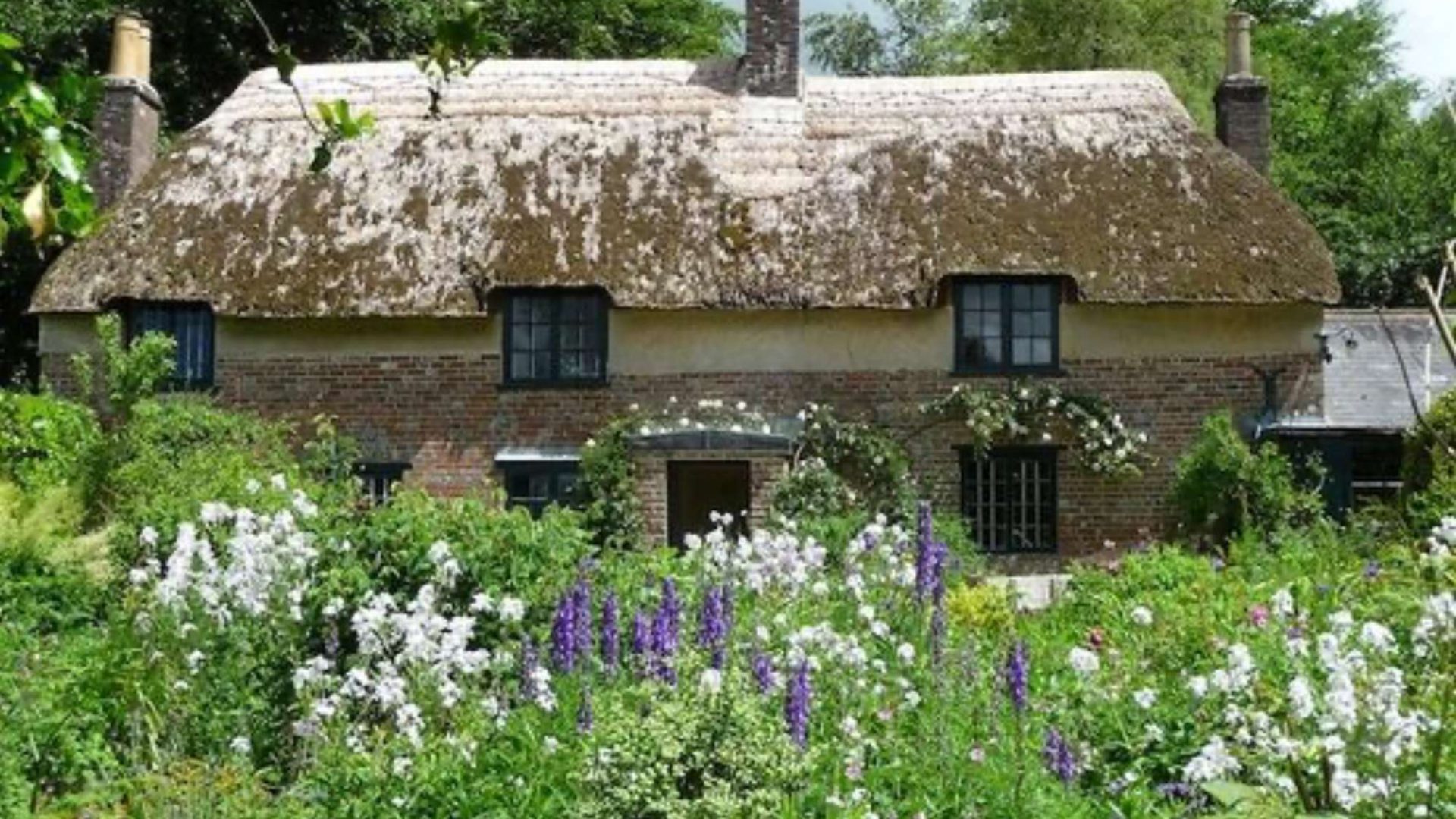

Few writers are as deeply rooted in their landscape as Thomas Hardy. The celebrated novelist and poet was not only born and buried in Dorset—he immortalised it. Hardy’s Wessex, the fictional setting for many of his works, is a richly imagined version of the rural southwest, with Dorset at its very heart.
For lovers of literature, Hardy’s Dorset is more than a location—it’s an experience. To follow his footsteps through the countryside is to time-travel through a Victorian world of beauty, struggle, tradition, and change.
Thomas Hardy
Thomas Hardy (1840–1928) was born in the tiny hamlet of Higher Bockhampton, just outside Dorchester, in what was then rural Wessex and is now the modern county of Dorset. His birthplace, a modest cob and thatch cottage built by his great-grandfather, shaped his worldview. The surrounding woodland, wild heathland, and village life made deep impressions on the young Hardy—many of which would resurface in his fiction and poetry.
The son of a stonemason and a well-read mother, Hardy was a sensitive and bookish child. His early education came from local schools and from his own voracious reading. Initially trained as an architect in London, Hardy never quite felt at home in the city and eventually returned to Dorset. But those years of social observation among the upper classes and rapid urban development had lasting effects, especially in his themes of class, tradition, and industrialisation.
Despite being known best as a novelist, Hardy always considered himself a poet first and foremost. Over his lifetime, he published more than 900 poems—often melancholic, philosophical, and deeply personal. His poetic work spans themes from rural life to lost love, and even to the horrors of World War I.
Thomas Hardy’s Novels and Their Dorset Roots
Hardy’s novels are steeped in the landscape, people, and social traditions of Dorset. While he named his fictional world “Wessex” (an ancient Saxon kingdom), many of his locations are thinly veiled representations of real places in the county. His works are dramatic, tragic, and often critical of the social norms of the time—especially the role of women, religion, and class.
Thomas Hardy's Major Works and Where to Find Them in Dorset

Far from the Madding Crowd (1874)
Hardy’s breakthrough novel, this pastoral tale of love and resilience was set in “Weatherbury”, based on Puddletown, not far from his childhood home. Gabriel Oak, Bathsheba Everdene, and Sergeant Troy became some of his most enduring characters. Visit St Mary’s Church in Puddletown to see the inspiration for Weatherbury Church.

The Mayor of Casterbridge (1886)
Perhaps his most famous work set in Dorchester (which Hardy called “Casterbridge”), this tragic story follows Michael Henchard, a man who rises and falls through a mixture of fate and personal folly. You can walk the streets of Dorchester and literally trace Henchard’s footsteps. Maumbury Rings and The King’s Arms Hotel (where Hardy often stayed) are directly referenced.

Tess of the d’Urbervilles (1891)
A dark, powerful critique of Victorian morality, Tess’s doomed story plays out in the rolling hills of Blackmoor Vale, which corresponds to Marnhull, Evershot, and Shaftesbury. St Michael’s Church in Marnhull is often believed to be where Tess and Angel Clare married.

Jude the Obscure (1895)
A controversial novel at the time of its release (dubbed “Jude the Obscene” by critics), this story of a working-class man’s aspirations and society’s repressions draws heavily from Hardy’s architectural experiences. Christminster, the stand-in for Oxford, looms over Jude’s life, but the rural scenes reflect Stinsford and Cerne Abbas.

Return of the Native (1878)
Set on Egdon Heath, a symbolic, brooding landscape inspired by Black Heath and Thorncombe Woods near Hardy’s birthplace. This novel is one of Hardy’s most atmospheric, and you can walk the heaths today, largely unchanged.

Under the Greenwood Tree (1872)
This gentle romantic novel follows the courtship of Dick Dewy and Fancy Day in the village of Mellstock, based on Stinsford and Bockhampton. It’s a nostalgic snapshot of Hardy’s own youth, featuring rural customs, church musicians, and close-knit community life. St Michael’s Church in Stinsford and the surrounding Thorncombe Woods provide the real-world setting.
Thomas Hardy's Poems
While Hardy’s novels brought him fame, it was his poetry that remained closest to his heart. His verse is often autobiographical—none more so than his poems about his first wife, Emma, written after her death. Though estranged in life, her passing stirred a profound outpouring of regret and emotion in his later works.
His poem “The Voice” is said to have been inspired by the windswept paths around Stinsford, where Emma was originally buried (and where Hardy’s heart was eventually interred).
Explore Thomas Hardy’s Dorset
If you want to live and breathe Thomas Hardy, Dorset offers a rich trail of landmarks, homes, and countryside.
1. Thomas Hardy’s Cottage – Higher Bockhampton
Owned by the National Trust, this is where Hardy was born and wrote his first novels, including Under the Greenwood Tree and Far from the Madding Crowd. The Thomas Hardy Cottage Dorset setting is magical: nestled in Thorncombe Woods, with roses round the door and birdsong in the air, it’s easy to see why Hardy was inspired here.
You can also explore the Hardy Trail, which meanders through woods and heathland he knew intimately.
📍 Top Tip: Visit early or midweek for a quieter experience. The adjoining visitor centre offers excellent context for your visit.
2. Max Gate – Dorchester
The Thomas Hardy House that he designed and lived in for over 40 years. This elegant red-brick Victorian villa is where Hardy wrote some of his most mature works, including Tess and Jude. The house has been carefully restored and gives a real sense of the writer’s daily life, from his study to the terraced garden he designed himself.
Look out for the pet cemetery, where Hardy’s beloved dog, Wessex, is buried.
📍 Location: Just outside Dorchester, it’s an easy walk or drive from town.
3. Stinsford Church – Hardy’s Resting Place
Also known as St Michael’s Church, this is where Hardy was baptised, where his first wife Emma is buried, and where his heart was interred (his ashes rest in Poet’s Corner at Westminster Abbey).
It’s a tranquil, deeply moving place that feels almost suspended in time.
📍 Why Visit? To reflect on Hardy’s roots and poetic soul.
4. Sturminster Newton – Hardy’s Writing Retreat
A charming village north of Dorchester where Hardy lived briefly and wrote Return of the Native. He adored the Sturminster Newton Mill and often walked by the River Stour for inspiration.
📍 Local Tip: Bring a picnic and enjoy the riverside trails—Hardy often walked here with Emma.
5. Dorchester (Casterbridge)
Walk the streets of Hardy’s Casterbridge! Visit:
-
The Dorset County Museum (which houses Hardy memorabilia, manuscripts, and his personal study)
-
Maumbury Rings, an ancient amphitheatre mentioned in his works
-
The King’s Arms Hotel, where Hardy attended banquets
Hardy’s Dorchester blends literary history with lively market-town charm.
Hardy Today
More than just romantic country tales, Thomas Hardy Novels speak to timeless themes: the individual versus society, fate, justice, and the natural world. His characters—especially the women like Tess and Bathsheba—are nuanced, tragic, and ahead of their time.
Hardy also stands out for his honest portrayal of rural England during a period of massive social change. His stories echo with the sounds of agricultural life, the tolling of church bells, and the heavy silences of moral complexity.
He was a modernist before modernism. A realist with a poet’s heart.
Thomas Hardy’s Dorset
Whether you’re a lifelong Hardy reader, a history lover, or simply curious about the landscapes that inspired one of England’s greatest writers, there’s no better way to experience it than by staying in the heart of Hardy’s Dorset.
At Dorset Cottage Holidays, we offer a wide range of beautiful self-catering properties perfectly placed for exploring Hardy country. Stay close to the heart of it all with cottages near Dorchester—the real-life Casterbridge—or enjoy a coastal retreat in Weymouth, featured in Hardy’s work as Budmouth. From countryside hideaways to seaside stays, our holiday homes let you soak up the scenery, history, and timeless charm that shaped Hardy’s world.
Step into the story. Wander the woodland trails he once walked, visit the homes he lived in, and see the villages that inspired his novels. Hardy’s Dorset is still here—waiting for you to discover it.
